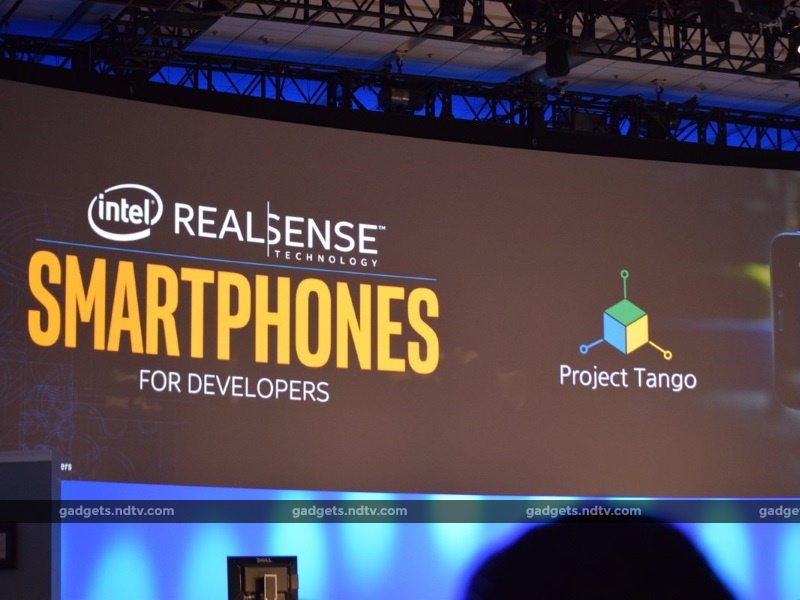- Home
- Laptops
- Laptops News
- IDF 2015: Intel Demos New Features for PC and Smartphone Security and Immersiveness
IDF 2015: Intel Demos New Features for PC and Smartphone Security and Immersiveness
By Jamshed Avari | Updated: 19 August 2015 17:32 IST

Click Here to Add Gadgets360 As A Trusted Source

Advertisement
Intel CEO Brian Krzanich kicked off the company's annual Intel Developer Forum with a keynote address that focused on the increased personalisation and intelligence of the hardware, software and services that will come to define technology in the near future. Krzanich framed his talk in terms of three basic assumptions that he said the company is now making when it comes to focusing its efforts.
The first assumption is that sensors are going to be increasingly important parts of products, allowing users to interact with them using natural sound, sight and touch for more immersive, human experiences. The second is that devices will be smarter and more connected, opening up possibilities for devices and experiences that haven't till now been considered tech-related. The third is that users will treat technology as extensions of themselves, expecting more personalised experiences.
Krzanich ran through several demonstrations on stage:
- Wake On Voice, developed in collaboration with Microsoft, allows users to wake their Windows 10 devices from sleep or standby with a simple voice command, building on Windows 10's Cortana capabilities. The device is always listening, so it can be woken up just by saying "Hey Cortana, wake up". The functionality will be available on devices featuring Intel's Atom and Core processors thanks to dedicated digital sound processing logic.
- Reduced audio latency on Android devices, which should allow professional-level responsiveness and more natural expression when creating music with apps.
- Also in collaboration with Google, a Project Tango tablet with integrated Intel RealSense 3D cameras. The tablet was able to generate a 3D model of a room with distance and depth information, just by being waved around.
- A robot butler, the Savioke Relay, which can avoid obstacles and plot routes using its 3D depth-sensing cameras. It can be used in hotels to deliver room service or toiletries to guests on demand, and interact using a touchscreen and physical movements such as a little dance.
- A custom-built 3D racing simulator which tracked head movements to change the perspective of the visuals shown on screen. A driver could see the road better when turning corners, just as if he or she was turning his head when driving a real car.
- A camera developed by Razer especially for Twitch game streaming, which allows players to broadcast 3D avatars of themselves along with their streams so that viewers can see their reactions in real time.

- A digital mirror that lets shoppers try on clothes and not only change their colours digitally, but also compare two looks side by side and share them privately or socially.
- A clip for children's car seat belts that triggers an alarm when a parent's phone goes out of range, to alert him or her in case the baby has been left in the car inadvertently and might therefore be in danger.

- Digital vending machines with gesture-based controls which sense customers approaching and customise ads or product menus based on their gender, age, and potentially other demographics.

- A sensor module developed by BMX that knows a bike's range of motions and can identify and rate the quality of stunts performed in order to help riders improve.
- Enterprise wearables, such as an identity token bracelet that can replace passwords on Windows 10 machines and automatically log users in when they are close enough and lock terminals when they step away. Access is denied if the wearable breaks contact with the wearer's skin.
- A futuristic 3D display that lets users interact with virtual "floating" elements such as horizontal piano keys. There is an optical illusion of floating controls, and RealSense cameras to detect users' hand movements. Ultrasonic pulses disturb the air around the user's fingertips to provide the sensation of feedback from the virtual surface.
Disclosure: Intel sponsored the correspondent's flights and hotel for the event in San Francisco.
Comments
Catch the latest from the Consumer Electronics Show on Gadgets 360, at our CES 2026 hub.
Related Stories
Popular on Gadgets
- Samsung Galaxy Unpacked 2025
- ChatGPT
- Redmi Note 14 Pro+
- iPhone 16
- Apple Vision Pro
- Oneplus 12
- OnePlus Nord CE 3 Lite 5G
- iPhone 13
- Xiaomi 14 Pro
- Oppo Find N3
- Tecno Spark Go (2023)
- Realme V30
- Best Phones Under 25000
- Samsung Galaxy S24 Series
- Cryptocurrency
- iQoo 12
- Samsung Galaxy S24 Ultra
- Giottus
- Samsung Galaxy Z Flip 5
- Apple 'Scary Fast'
- Housefull 5
- GoPro Hero 12 Black Review
- Invincible Season 2
- JioGlass
- HD Ready TV
- Laptop Under 50000
- Smartwatch Under 10000
- Latest Mobile Phones
- Compare Phones
Latest Gadgets
- Honor Magic 8 RSR Porsche Design
- Honor Magic 8 Pro Air
- Infinix Note Edge
- Lava Blaze Duo 3
- Tecno Spark Go 3
- iQOO Z11 Turbo
- OPPO A6c
- Samsung Galaxy A07 5G
- Lenovo Yoga Slim 7x (2025)
- Lenovo Yoga Slim 7a
- Lenovo Idea Tab Plus
- Realme Pad 3
- Moto Watch
- Garmin Quatix 8 Pro
- Haier H5E Series
- Acerpure Nitro Z Series 100-inch QLED TV
- Asus ROG Ally
- Nintendo Switch Lite
- Haier 1.6 Ton 5 Star Inverter Split AC (HSU19G-MZAID5BN-INV)
- Haier 1.6 Ton 5 Star Inverter Split AC (HSU19G-MZAIM5BN-INV)
© Copyright Red Pixels Ventures Limited 2026. All rights reserved.






![[Sponsored] Haier C90 OLED TV | Dolby Vision IQ, 144Hz OLED and Google TV in Action](https://www.gadgets360.com/static/mobile/images/spacer.png)









